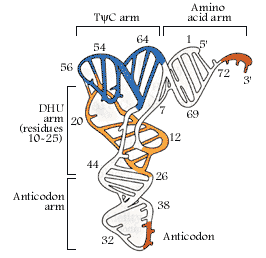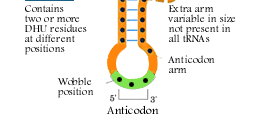|
|
About tRNA Transfer RNAs (tRNAs) are small RNA molecules containing 75 to 95 nucleotides. Cells contain many different tRNA molecules. Most of the tRNAs function as carriers of amino acids and participate in protein synthesis. However, tRNAs also take part in reactions not related to ribosome-dependent translation. The first nucleic acid to be completely sequenced was the tRNA that binds the amino acid alanine (tRNAAla). This pioneering work was performed by Holley and co-workers long before the invention of today's rapid sequencing techniques. For his work, Holley received the 1968 Nobel Prize in Physiology or Medicine.
The obtained sequence information showed that tRNAAla (tRNA with an anticodon corrsponding to the amino acid alanine see the genetic code) contained a series of inverted sequences that allows folding of the linear RNA molecule in a cloverleaf configuration (secondary structure). It was subsequently shown that the cloverleaf structure was compatible with the sequence of almost all tRNAs. In the cloverleaf model, the inverted sequences form four double-helical segments. The two ends of the molecule form the amino acid arm or acceptor stem. A single strand sequence - CCA - protrudes from the 3’-end of the molecule. The terminal A is coupled to the amino acid during amino acid activation. The next arm, moving clockwise, is the TPsiC arm. This arm got its name from the occurrence of the sequence TPsiC in almost all tRNAs (Psi, pseudouridine, is a modified U). In eukaryotic initiator tRNAs, TPsiC is substituted for by AUC or APsiC. The next arm is the variable arm which may contain between 4 and 21 nucleotides. Adjacent to the variable arm is the anticodon arm with the three nucleotide anticodon which pairs with the codon during translation. The last arm of the tRNA is the DHU-arm named after the occurrence of dihydrouridine in all tRNAs. In the early 1970s, the three-dimensional structure of tRNA was determined by X-ray diffraction of tRNA crystals. It was found that the basic cloverleaf structure proposed by Holley was further folded into an L-shaped structure. In this structure the CCA-end and the anticodon loop are positioned at opposite ends of the molecules while the DHU and the TPsiC-arms are folded in along the axis of the molecule. Immediately after synthesis, the tRNA, like all RNAs, contains the four bases A, G, C and U. However, mature tRNAs can contain modified bases i.e., bases other than the normal A,U,G, and C. These modifications are introduced after transcription of the tRNA. Most modified bases occur at restricted sites in the tRNA. The first base in the anticodon, the wobble position, often contains modified bases that allow formation of unusual base pairs with the third base in the mRNA codon.
|
||||||


